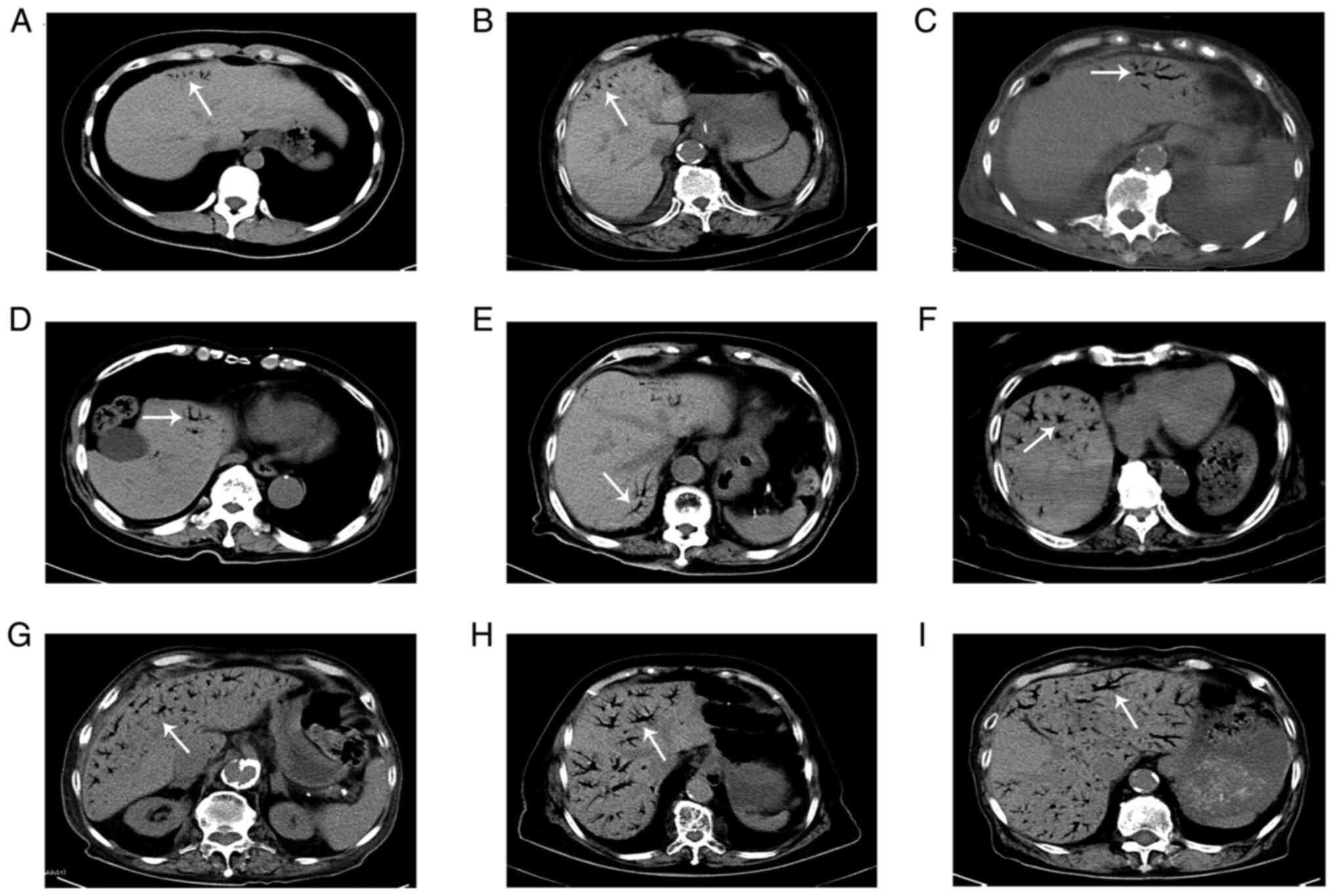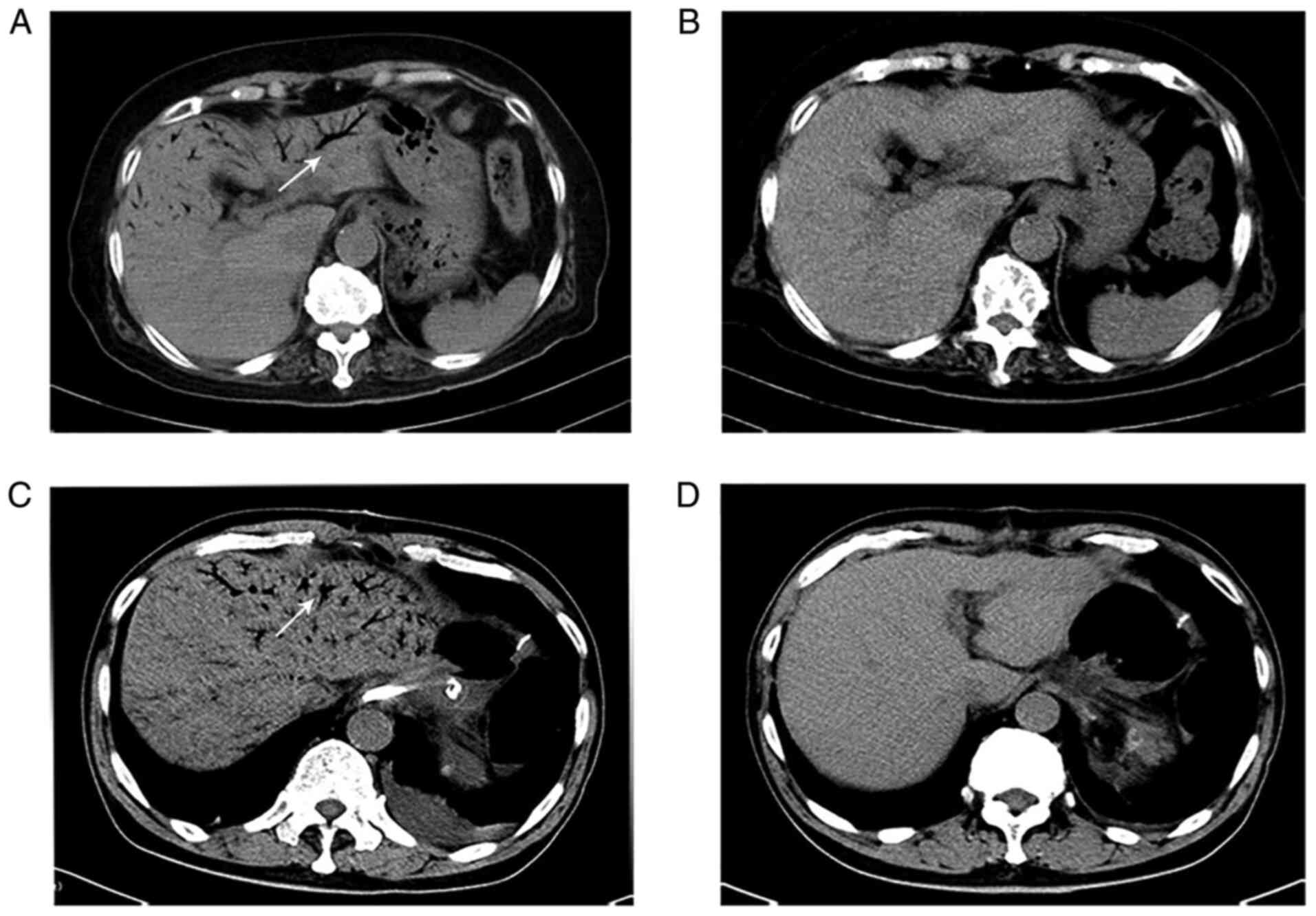|
1
|
Wolfe JN and Evans WA: Gas in the portal
veins of the liver in infants; a roentgenographic demonstration
with postmortem anatomical correlation. Am J Roentgenol Radium Ther
Nucl Med. 74:486–489. 1955.PubMed/NCBI
|
|
2
|
Liebman PR, Patten MT, Manny J, Benfield
JR and Hechtman HB: Hepatic-portal venous gas in adults: Etiology,
pathophysiology and clinical significance. Ann Surg. 53:231–234.
1978.PubMed/NCBI View Article : Google Scholar
|
|
3
|
Capolupo GT, Masciana G, Carannante F and
Caricato M: Hepatic portal venous gas after colonoscopy: A case
report and review. Int J Surg Case Rep. 51:54–57. 2018.PubMed/NCBI View Article : Google Scholar
|
|
4
|
Alqahtani S, Coffin CS, Burak K, Chen F,
Gregor JM and Beck P: Hepatic portal venous gas: A report of two
cases and a review of the epidemiology, pathogenesis, diagnosis and
approach to management. Can J Gastroenterol. 21:309–313.
2007.PubMed/NCBI View Article : Google Scholar
|
|
5
|
Hou SK, Chern CH, How CK, Chen JD, Wang LM
and Lee CH: Hepatic portal venous gas: Clinical significance of
computed tomography findings. Am J Emerg Med. 22:214–218.
2004.PubMed/NCBI View Article : Google Scholar
|
|
6
|
von Elm E, Altman DG, Egger M, Pocock SJ,
Gøtzsche PC and Vandenbroucke JP: STROBE Initiative. The
Strengthening the Reporting of Observational Studies in
Epidemiology (STROBE) Statement: Guidelines for reporting
observational studies. Int J Surg. 12:1495–1499. 2014.PubMed/NCBI View Article : Google Scholar
|
|
7
|
Kinoshita H, Shinozaki M, Tanimura H,
Umemoto Y, Sakaguchi S, Takifuji K, Kawasaki S, Hayashi H and
Yamaue H: Clinical features and management of hepatic portal venous
gas: Four case reports and cumulative review of the literature.
Arch Surg. 136:1410–1141. 2001.PubMed/NCBI View Article : Google Scholar
|
|
8
|
Shah PA, Cunningham SC, Morgan TA and Daly
BD: Hepatic Gas: Widening Spectrum of Causes Detected at CT and US
in the Interventional Era. Radiographics. 31:1411–1413.
2011.PubMed/NCBI View Article : Google Scholar
|
|
9
|
Suzuki S, Takeuchi Y, Ishihara R and
Kawakami H: Hepatic portal venous gas following colonic endoscopic
submucosal dissection. Internal Med. 58:755–756. 2019.PubMed/NCBI View Article : Google Scholar
|
|
10
|
Solakoglu T, Sari SO, Koseoglu H, Basaran
M, Akar M, Buyukasik S and Ersoy O: A case of hepatic portal venous
gas after colonoscopy. Arab J Gastroenterol. 17:140–142.
2016.PubMed/NCBI View Article : Google Scholar
|
|
11
|
Matsuoka T, Kobayashi K, Lefor AK, Sasaki
J and Shinozaki H: Mesenteric ischemia with pneumatosis
intestinalis and portal vein gas associated with enteral nutrition:
A series of three patients. Clin J Gastroenterol. 13:1160–1164.
2020.PubMed/NCBI View Article : Google Scholar
|
|
12
|
Koizumi C, Michihata N, Matsui H, Fushimi
K and Yasunaga H: In-hospital mortality for hepatic portal venous
gas: Analysis of 1590 patients using a japanese national inpatient
database. World J Surg. 42:816–822. 2018.PubMed/NCBI View Article : Google Scholar
|
|
13
|
McElvanna K, Campbell A and Diamond T:
Hepatic portal venous gas-three non-fatal cases and review of the
literature Ulster Med. J. 81:74–78. 2012.PubMed/NCBI
|
|
14
|
Moussa M, Marzouk I, Abdelmoula K,
Manamani A, Dali N, Farhat LC and Hendaoui L: Role of Computed
tomography in predicting prognosis of Hepatic portal venous gas.
Int J Surg Case Rep. 30:177–182. 2017.PubMed/NCBI View Article : Google Scholar
|
|
15
|
Wiesner W, Khurana B, Ji H and Ros PR: CT
of acute bowel ischemia. Radiology. 226:635–650. 2003.PubMed/NCBI View Article : Google Scholar
|
|
16
|
Moser A, Stauffer A, Wyss A, Schneider C,
Essig M and Radke A: Conservative treatment of hepatic portal
venous gas consecutive to a complicated diverticulitis: A case
report and literature review. Int J Surg Case Rep. 23:186–189.
2016.PubMed/NCBI View Article : Google Scholar
|
|
17
|
Wayne E, Ough M, Wu A, Liao J, Andresen
KJ, Kuehn D and Wilkinson N: Management algorithm for pneumatosis
intestinalis and portal venous gas: Treatment and outcome of 88
consecutive cases. J Gastrointest Surg. 14:437–448. 2010.PubMed/NCBI View Article : Google Scholar
|
|
18
|
Soon WC, Liu KY and Blunt D: Hepatic
portal venous gas. Clin Case Rep. 3:518–519. 2015.PubMed/NCBI View
Article : Google Scholar
|
|
19
|
Koami H, Isa T, Ishimine T, Kameyama S,
Matsumura T, Yamada KC and Sakamoto Y: Risk factors for bowel
necrosis in patients with hepatic portal venous gas. Surg Today.
45:156–161. 2015.PubMed/NCBI View Article : Google Scholar
|
|
20
|
Nelson AL, Millington TM, Sahani D, Chung
RT, Bauer C, Hertl M, Warshaw AL and Conrad C: Hepatic portal
venous gas: The ABCs of management. Arch Surg. 144:575–581.
2009.PubMed/NCBI View Article : Google Scholar
|
|
21
|
Shah A, Al Furajii H and Cahill RA:
Symptomatic pneumatosis intestinalis (including portal venous gas)
after laparoscopic total colectomy. World J Gastrointest Endosc.
6:564–567. 2014.PubMed/NCBI View Article : Google Scholar
|
|
22
|
Iwai N, Handa O, Naito Y, Dohi O, Okayama
T, Yoshida N, Kamada K, Uchiyama K, Ishikawa T, Takagi T, et al:
Stenotic ischemic enteritis with concomitant hepatic portal venous
gas and pneumatosis cystoides intestinalis. Internal Med.
57:1995–1999. 2018.PubMed/NCBI View Article : Google Scholar
|
|
23
|
Hong I, Hong SW, Chang YG, Lee B, Lee WY,
Ohe HJ and Kim YK: Successful conservative management of hepatic
portal venous gas due to anastomosis leakage after a sigmoidectomy.
Ann Coloproctol. 35:282–284. 2019.PubMed/NCBI View Article : Google Scholar
|
|
24
|
Yasuda T, Yagi N, Nakahata Y, Kurobe T,
Yasuda Y, Omatsu T, Obora A and Kojima T: A case of phlegmonous
gastritis with hepatic portal venous gas caused by Aeromonas
hydrophila successfully treated with medication. Clin J
Gastroenterol. 13:281–286. 2020.PubMed/NCBI View Article : Google Scholar
|
|
25
|
Dibra R, Picciariello A, Trigiante G,
Labellarte G, Tota G, Papagni V, Martines G and Altomare DF:
Pneumatosis intestinalis and hepatic portal venous gas: Watch and
wait or emergency surgery? a case report and literature review. Am
J Case Rep. 21(e923831)2020.PubMed/NCBI View Article : Google Scholar
|
















